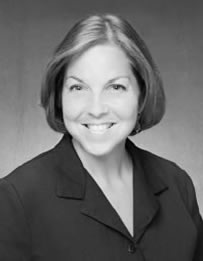 |
 |

 |
||
I started collecting family tree information when I was eleven years old, directly from my great-grandmother who lived with us. Her turn-of-the-century memories fascinated me. Sometimes she told older family stories that her grandmother had passed on to her.
It was fortunate I started so early. Perhaps it was an instinct I had that she would not be with us much longer. By the time she passed away when I was thirteen, I had much to go on. When I visited Oakwood Cemetery in Richmond, I could see the graves of her parents and grandparents. The stones were old, yet my great-grandmother’s stories made me feel close to all those who had come before me. How fortunate I was to have access to all that first-hand history! My great-grandmother remembered that her mother had been a little girl at the time of the Civil War. “My grandmother saw the Confederates comin’ and threw the silver into Mama’s toy chest, then sat Mama on it,” she told me. “But they shouldn’t have been afraid of the Confederates," I cried in disbelief. "They were Virginians!” “Yes, but they lived near the West Virginia border, don’t you know, so they weren’t safe from Yankees or Confederates.” One of the soldiers had taunted my great-great grandmother with the words, “What do you have in that chest, little girl?” How her heart must’ve raced as the soldier reached for her—until his comrade stopped him. “Aw, she’s just a little girl. Leave her alone.” My grandfather and grandmother told me more stories of old Virginia. My father grew up in Sicily during World War II and was also fond of retelling family stories. As a starving Sicilian boy, he recalled selling almonds to the German army and the sound of the bombs as the Allies flew over. My curiosity piqued, I wanted to know more. Where did all these ancestors come from? Who were their parents? I somehow saw them as a river flowing into me through time. I wrote this little verse, which made its way into my book years later: All their eyes are upon me. I began researching in earnest in 1976 for a 9th grade family tree project inspired by the Bicentennial and Roots. Thirty-five years later, I’m still at work on the assignment! I continued researching all through college and graduate school. When I worked in downtown Richmond, I walked to the Library of Virginia each day, pulling and copying records as fast as I could. I only had an hour, and that included walking time! As a young mother, I carried my infant daughter to the same library. I still enjoyed the thrill of being a history detective. (How ironic that, fifteen years later, the little baby in the front carrier, Sarah, designed the cover of my book for me.) One day, in 1994, something unusual happened. For the first time, one of my ancestors found me. I had gone to the Library of Virginia and pulled some books that looked to be helpful off the shelf. Then another book caught my eye that appeared totally unrelated to all my searches. Something drew me to that dusty old book. With a thousand books to choose from, why that one? But I felt I had to have it. For hours I checked every lead and searched all the relevant books I could find. Nothing. I was preparing to leave when I noticed that old volume was still sitting on the corner of my table. I had never opened it. Well, what was there to lose? I browsed the index for a moment...and then a familiar name caught my eye. It was an ancestor named Archer Cox, who lived in Mecklenburg, Virginia, in the early 1800s. He had been a cold trail, but it turned out this book traced him all the way back to Jamestown...and suddenly I had links taking me all the way This was a huge find, bringing me dozens of ancestors all at once. Cecily, I learned later, had been a Jamestown mystery for professional genealogists for 120 years. Who was she, and why had she come to Virginia alone in 1611 as an eleven year-old? And why had her mother allowed her to do so? Was she a street orphan? Or was her mother simply negligent? What was her story, genealogists wanted to know—particularly since so many Virginians could claim descent from this mystery child. If no one else could solve this, why would I think I could? So I set her aside to pursue other research. Cecily, however, would not set me aside. When I tried to trace other lines, I often turned up references to her instead, as though she were pursuing me. “You are searching for the wrong ancestors. I should be the one you’re looking for!” she seemed to say. Why couldn’t I shake this sense that she wanted her story told and wanted me to be the one to do it? Frankly, I felt she had the wrong person—whatever her lost background may have been, it seemed too deep, too old, and too obscure to tackle. Once, in a used bookstore in Williamsburg, I found a thin old volume called Ancient Adventurers (by Samuel Bemiss) amongst shelves of Virginia books . Although I had no idea what it was about, I nearly felt electricity coming from it. Curious, I picked it up and leafed through it. To my surprise, I found this passage: “Ann Burras, Temperance Flowerdieu and Sisley Jordan can represent all the unsung heroines of that heroic age. They possessed that courage, stamina, and faith in the new land characteristic of all their ‘sisters.’ They embodied the spirit and fortitude of all the silent partners of the master adventurers in the New World, who founded a nation and whose blood is the strength and the backbone of America today. Ann, Temperance, and Sisley can represent all of them. They were contemporaries of Pocahontas but, unlike Pocahontas, their bodies are forever a part of Virginia’s soil.” A strange feeling came over me—as if Cecily were prodding me to find this particular passage because she was so proud of it. The thought caused me to laugh aloud, saying in a whisper, “Cecily, you are so vain!” Yet I agreed with Mr. Bemiss. These women were unsung, and I began to realize I did want to tell their stories, focusing on Cecily. (Would she have it any other way?) However to do this, I would have to uncover the real people behind the names in dusty books. Perhaps Cecily would help me... Over time, I pieced together her ancestry, solved the puzzle of who her mother was (after I began writing the book), and ultimately answered the question of why her mother allowed her to travel alone. And it had nothing whatsoever to do with negligence. It was a strategically executed plan—and it worked. Finally, I understood. Cecily was not so vain that she wanted her own story told. For 120 years, researchers had maligned her mother’s name. Perhaps Cecily wanted the record set straight. Her mother Joan had not been irresponsible but had survived great horrors in Jamestown—and lived to tell about them. Although Cecily had indeed come over alone, there were sound reasons. The answer lay in that no one had connected this woman with this child. Did Cecily really help me? If you believe in such things, I can tell you that when I have been at work on the manuscript, I’ve had the desk lamp flicker on and off. Once, my husband, taking my place at the desk, felt a tap on his shoulder. No one was there.
It seems history has largely overlooked this courageous group of one hundred women and children. There was little information on them, no books dedicated to telling their authentic story, and virtually no information on who they might have been in England before becoming Jamestown Adventurers. As I unraveled Cecily’s genealogy, I traced her mother back to the Norman Conquest and discovered that she was a direct descendent of Lady Godiva. Now a story formed in my mind, a chain of mothers and daughters. “You are our granddaughter. Remember us.” I could almost feel their voices urging me on. I had traced my river to its source at last. After I understood who, I needed to know where, why, and how. I traveled to Jamestown, Henricus, Roanoke Island, the Elizabethan Gardens in North Carolina, and finally to England, looking for clues, talking to interpreters...until one day I saw that in some mystical way the story—their story—had come together. During the writing, Joan became so real to me that I knew her voice and what she would say in any situation. I began to understand her and to sympathize with her. In the novel, I was dedicated to maintaining historical accuracy, and I have tremendous respect for all these women and children. I did not sugarcoat their story, but I did not defile it either. These one hundred women, in my mind, were the first American heroines as Bemiss suggested. God bless each one for their courage. Most lost their lives and were buried in unmarked graves. But a few, like Joan, at least have a name and a story which one can trace. All the women and children who ventured to Jamestown in the first two years of settlement, most of them unknown and unremembered, still have something to say: “Do not forget us.” |
||
![]()
Home • About Connie • Inspiration • Books • Speaking • Book Clubs • Resources • Contact
Copyright 2011 Connie Lapallo








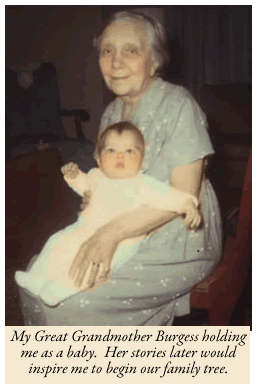 Although I had heard these stories all my life, at eleven it occurred to me to start writing them down and to question her further. I made notes of names and dates, pressed her for details, and began drawing family trees. I still have these, written in my simple fifth grader’s hand.
Although I had heard these stories all my life, at eleven it occurred to me to start writing them down and to question her further. I made notes of names and dates, pressed her for details, and began drawing family trees. I still have these, written in my simple fifth grader’s hand. 
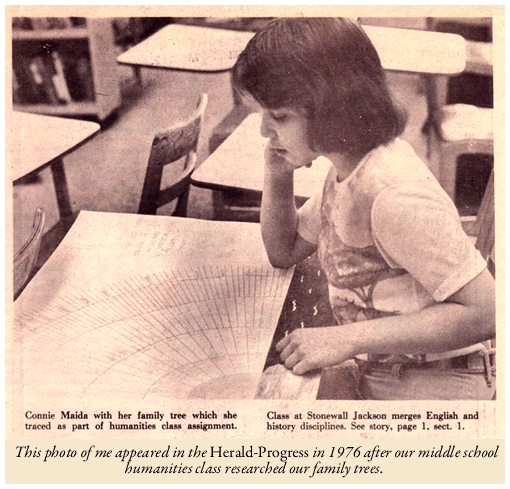
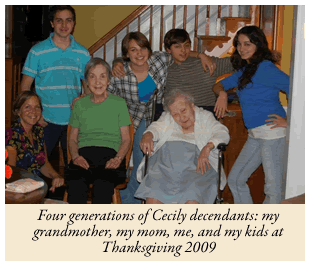 back to a woman named Temperance Bailey and to her mother, Cecily (or Sisley).
back to a woman named Temperance Bailey and to her mother, Cecily (or Sisley).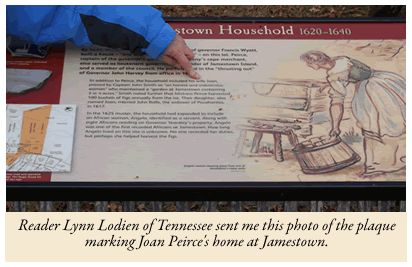 I shrugged. “It’s just Cecily,” I told him. “She wants you to move aside and let me get back to writing about her. She’s like that.”
I shrugged. “It’s just Cecily,” I told him. “She wants you to move aside and let me get back to writing about her. She’s like that.”